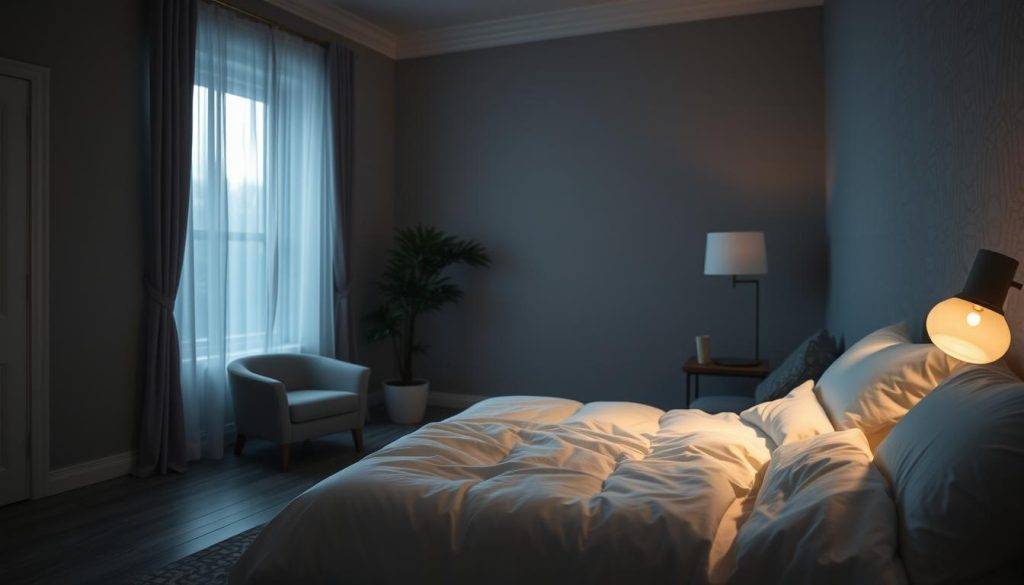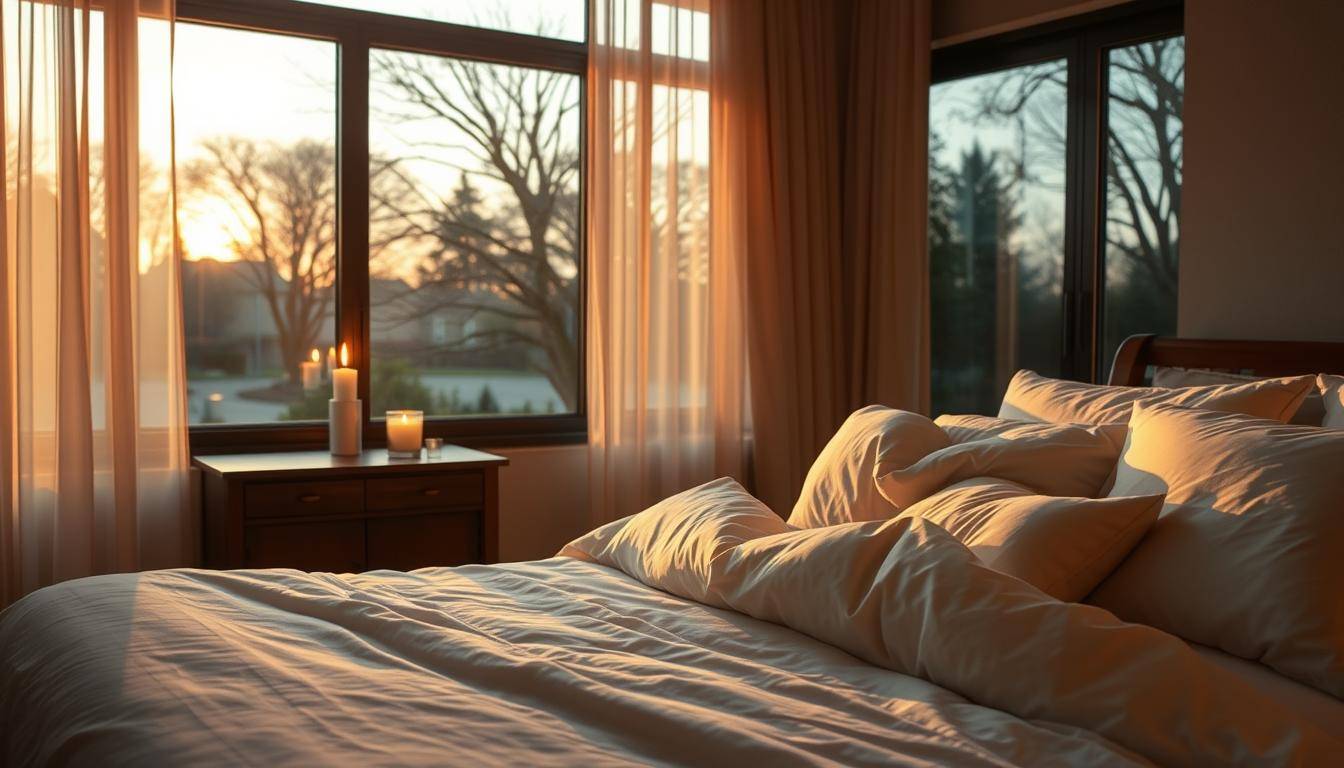“You have power over your mind—not outside events. Realize this, and you will find strength.” — Marcus Aurelius
The modern mind often races at night. In a national survey, 44 percent of adults said stress caused sleepless nights at least once in the past month. Johns Hopkins expert Luis F. Buenaver explains how repeated stress can lock the body into a wired state, making each day harder after a poor night.
This introduction previews a simple, science-backed routine that helps you fall asleep more reliably and build a foundation for a good night sleep and long-term health. It blends short breathing exercises, progressive muscle relaxation, and device-free wind-down steps you can do in minutes.
The goal is clear: turn a racing mind into restorative sleep so your bed becomes a cue for calm, not worry. The protocol focuses on practical actions that help sleep tonight and support daytime productivity tomorrow.
Key Takeaways
- Simple, brief practices can lower cortisol and support better night sleep.
- The guide gives a step-by-step routine to help you fall asleep even when feeling tired.
- Device-free wind-down, breathing, and muscle work combine to make bed calmer.
- Expert-backed methods reduce anxiety and make good night sleep more consistent.
- The protocol is efficient—minutes of practice, not hours—so it fits a busy day.
Why Stress Disrupts Sleep Right Now: Understanding the Mind-Body Loop
A persistent stress response quietly reroutes the body away from repair and toward readiness. When that happens, breathing quickens and heart rate climbs. Stress hormones like cortisol and adrenaline rise, and the normal sleep cycle gets pushed off track.
Johns Hopkins expert Luis F. Buenaver explains that repeated activation keeps the system from returning to baseline — “like running an engine in fifth gear all the time.” That loop links poor rest and increased anxiety across the next day, making it harder to unwind come night.
The good news: the relaxation response reverses this pattern. Brief, intentional breathing and targeted relaxation techniques slow the heart and ease muscle tension. Over time these shifts support better sleep and improved mental health.
- Stress primes the body for action, not rest, altering the sleep cycle.
- Screens and stimulating content act like stressful situations; limit them before bedtime.
- Simple methods — including progressive muscle relaxation — help reset physiology and reduce circulating stress hormones.
“Planned relaxation — not passive TV — switches on the relaxation response and promotes rest.”
The Bedtime Stress-Relief Protocol: A Step-by-Step How-To
A deliberate wind-down sequence primes the nervous system to move from alert to restful. Start with a brief device-free period and choose calming activities—reading, a warm bath, light stretches, or quietly planning tomorrow—so the bed becomes a cue for calm.

Gentle breathing for a calmer heart rate
Sit or lie comfortably and breathe slowly for about five minutes. Inhale into the belly and exhale fully; try a simple phrase with each cycle. This focused breathing lowers heart rate and helps you fall asleep more easily.
Progressive muscle relaxation: head-to-toe release
Take a few breaths, then tense and release each group from head and neck down to feet. Hold tension on the inhale, release on the exhale, and notice how the muscle contrast feels.
Short meditation and journaling
Add brief meditation bursts to shift attention away from anxious thoughts. Journal five to ten minutes to offload worries into next-day tasks so the mind stops rehearsing.
Two-week practice plan
Practice daily 20–25 minutes for two weeks. Rate tension 0–10 before and after each session, note what helps most, and keep the best relaxation technique. Over time the routine signals the body to relax and you will sleep better with less effort.
Optimize Your Night: Timing, Sleep Hygiene, and Lifestyle Tweaks
Small evening choices shape how quickly the body moves from wakefulness to rest. Timing, light exposure, and simple habits combine to support better sleep and lower evening anxiety. These adjustments are practical and easy to adopt.

Move smart: schedule exercise earlier in the day
Regular exercise reduces daily stress and helps the body unwind. Aim to finish vigorous exercise at least two to three hours before hours bedtime so your nervous system can settle for night sleep.
Food and drink choices
Avoid heavy or spicy meals, caffeine late in the day, and excess fluids in the evening. These choices lower reflux and nighttime awakenings that fragment good sleep.
Protect your sleep cycle
Cap screens 30–60 minutes before bedtime. Blue light and stimulating content raise alertness; swap scrolling for calming activities to help sleep readiness.
Build a relaxing bedroom
Keep the room cool, dark, and clutter-free. A consistent sleep schedule—same wake and lights-out time—trains the body clock and promotes consistent sleep.
| Area | Simple Action | Why it helps |
|---|---|---|
| Exercise | Finish vigorous workouts 2–3 hours before hours bedtime | Prevents late arousal and supports night sleep |
| Evening nutrition | Avoid heavy, spicy meals and late caffeine; limit fluids | Reduces reflux and bathroom trips that break sleep |
| Light & devices | Stop screens 30–60 minutes before close bedtime | Limits blue light; lowers alertness and anxiety |
| Bedroom setup | Cool temperature, blackout shades, tidy surfaces | Signals the body that the bed is for rest and a good night |
Track Progress, Troubleshoot, and Know When to Get Expert Help
Small, consistent measurements reveal patterns that a single night cannot. Tracking makes progress visible and shows which practices truly help you sleep better. A simple log can guide choices and speed improvement.
Measure what matters
Rate tension on a 0–10 scale before and after your relaxation practice. Note perceived sleep quality duration, total hours, and whether you fall asleep faster. Track which heart-calming cue—breath, posture, or muscle release—works fastest.
- Nightly stress ratings and sleep quality duration.
- Time to fall asleep and number of awakenings during night sleep.
- Quick notes on triggers—late caffeine, screens, or intense evening talks.
When to consult an expert
If insomnia continues beyond two weeks despite consistent practice, seek an expert evaluation. Ongoing sleeplessness can signal underlying issues that affect mental health and daily function.
Evidence-based treatments—CBT-I and cognitive behavioral stress management (CBSM)—help reduce stress and restore full night sleep. These approaches reshape thoughts and habits that keep the sleep cycle active.
Troubleshoot, get support, and protect your mental health
Scan your body for cues like jaw clenching or shoulder tension and use a quick muscle release to interrupt the pattern before bed. Recruit friends or family for brief check-ins to ease stressful situations and avoid compounding feeling tired across the week.
“Aim for steady progress—small gains in quality duration and fewer awakenings add up to a full night and better mornings.”
If depression or anxiety symptoms rise, prioritize professional care. Early action protects long-term health and helps you reach a reliable, good night sleep sooner.
Conclusion
Practicing a simple evening routine makes better sleep a dependable result. Stick to device-free wind-downs, gentle deep breathing, progressive muscle relaxation, and brief meditation to calm the heart and body in the same small span of time each night.
Daily use of these techniques lowers stress hormones, eases anxiety, and builds a neurological cue that helps you achieve consistent sleep and a good night more often.
Protect progress with solid sleep hygiene: cap screens, schedule exercise earlier, and avoid late caffeine or heavy meals so night sleep stays steady.
If problems persist beyond two weeks, consult a clinician about CBT-I or stress-focused care to restore night sleep and long-term health.
FAQ
What causes stress to disrupt sleep?
Stress triggers the body’s fight-or-flight response, raising stress hormones like cortisol and increasing heart rate. That physiological arousal keeps the mind alert and makes falling asleep difficult. Worry and rumination also keep neural circuits engaged, turning a normal sleep window into a sleepless cycle.
How quickly can relaxation techniques lower heart rate and calm the mind?
Simple breathing exercises and grounding practices can reduce heart rate and perceived tension within minutes. Techniques such as slow diaphragmatic breathing or box breathing engage the parasympathetic nervous system, producing measurable calming effects in short sessions of five to ten minutes.
What is progressive muscle relaxation and how does it help?
Progressive muscle relaxation guides you to tense, then release muscle groups from head to toe. This method reduces bodily tension, interrupts the stress response, and signals the brain that the body is safe—making it easier to drift into deeper, more restorative sleep.
When should exercise be scheduled to avoid interfering with sleep?
Aim to finish moderate to intense exercise at least three hours before bedtime. Morning or early afternoon workouts help reduce daytime stress and support sleep architecture, while late-night vigorous activity can elevate heart rate and delay sleep onset.
How does journaling help improve sleep quality?
Brief evening journaling or a to-do offload clears cognitive clutter. By transferring worries and tasks onto paper, you reduce nocturnal rumination and create mental space for relaxation, which supports faster sleep onset and steadier sleep through the night.
How long should one practice the protocol to see results?
Consistent daily practice for about two weeks—20 to 25 minutes each evening—allows you to test techniques, track stress ratings, and refine what works. Many people notice improved sleep within days; more robust changes in sleep quality often appear after consistent practice for two weeks or longer.
What sleep hygiene changes most reliably improve nights?
Key habits include keeping a consistent sleep schedule, limiting blue light before bed, making the bedroom cool, dark, and quiet, and avoiding heavy meals or caffeine late in the day. These tweaks reduce sleep-disrupting inputs and make relaxation techniques more effective.
When should someone seek professional help for insomnia?
If poor sleep persists beyond two weeks despite focused self-help, or if sleep problems significantly impair daytime functioning, consult a healthcare professional. Evidence-based options include cognitive behavioral therapy for insomnia (CBT-I), stress management therapy, or medical evaluation for underlying conditions.
Can mindfulness and meditation replace other sleep strategies?
Mindfulness and meditation are powerful for shifting attention away from stress, but they work best alongside sleep hygiene, breathing exercises, and physical relaxation like progressive muscle techniques. Combining approaches yields more reliable, sustained improvement.
How should someone track progress and know what’s working?
Track simple metrics: nightly sleep duration and quality, pre-sleep stress ratings, heart rate or resting pulse if available, and which techniques were used. Look for trends over two weeks—consistent improvements indicate an effective routine; small adjustments refine results.




























































